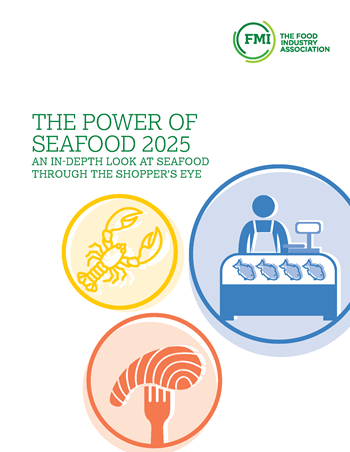BOSTON, MA — FMI - The Food Industry Association today released its Power of Seafood 2025 report at Seafood Expo North America. This seventh edition explores shifting consumer attitudes, purchasing behaviors and untapped opportunities for the seafood department despite lackluster category performance.
Misperceptions on Price, How to Purchase and Prepare Seafood Creates Barriers
The reasons for the decline in seafood sales vary, including shopper perceptions that seafood is expensive (79% of  consumers surveyed) and seen as a luxury (66%), even though the cost of seafood largely decreased in 2024.
consumers surveyed) and seen as a luxury (66%), even though the cost of seafood largely decreased in 2024.
Shoppers also expressed a lack of knowledge about how to purchase and prepare seafood. However, most consumers surveyed (93%) say they value the health benefits of seafood and view it as a high-quality, nutritious protein. Furthermore, the share of frequent seafood consumers – those who eat seafood at least two times a week – remains steady, and those shoppers (81%) continue to view seafood as an affordable option for their families.
“While 87% of shoppers view seafood as healthy, 42% of seafood is purchased by only 10% of shoppers,” said Steve Markenson, FMI’s vice president of research and insights. “This suggests shoppers view seafood as a healthy yet intimidating protein. Shoppers tell us they lack the knowledge on how to prepare seafood and how to buy or select seafood, which makes them hesitant to purchase. At the same time, shoppers tell us they want to be educated more about seafood options.”
Opportunities to Educate Shoppers on Seafood
Converting more consumers into occasional or frequent seafood shoppers is a key area of opportunity for food retailers. Additionally, 39% of frequent seafood customers are households with children, providing a tremendous opportunity for food retailers to better educate, attract and retain lifelong seafood shoppers. Interestingly, only 17% of seafood shoppers with children say that their children eat the same meal as they do when they prepare seafood at home.
“We know that once families cook and eat seafood regularly, they enjoy it,” said Rick Stein, vice president of fresh foods at FMI. “It is essential that food retailers break down perceptions that seafood is either too expensive or difficult to prepare. Grocers can be creative and partner with retail registered dietitian nutritionists to educate shoppers across channels – in-store, online, via apps and across social media platforms – on how to prepare cost-effective, nutritious meals with seafood, suggestions on buying different types of seafood and how to better reduce food waste, while showcasing the health benefits seafood offers.”
The Power of Seafood 2025 is made possible by the Alaska Seafood Marketing Institute.
For Media:
Media may contact FMI for a gratis copy of the Power of Seafood 2025 report.
 Industry Topics address your specific area of expertise with resources, reports, events and more.
Industry Topics address your specific area of expertise with resources, reports, events and more.
 Our Research covers consumer behavior and retail operation benchmarks so you can make informed business decisions.
Our Research covers consumer behavior and retail operation benchmarks so you can make informed business decisions.
 Events and Education including online and in-person help you advance your food retail career.
Events and Education including online and in-person help you advance your food retail career.
 Food Safety training, resources and guidance that help you create a company food safety culture.
Food Safety training, resources and guidance that help you create a company food safety culture.
 Government Affairs work — federal and state — on the latest food industry policy, regulatory and legislative issues.
Government Affairs work — federal and state — on the latest food industry policy, regulatory and legislative issues.
 Get Involved. From industry awards to newsletters and committees, these resources help you take advantage of your membership.
Get Involved. From industry awards to newsletters and committees, these resources help you take advantage of your membership.
 Best practices, guidance documents, infographics, signage and more for the food industry on the COVID-19 pandemic.
Best practices, guidance documents, infographics, signage and more for the food industry on the COVID-19 pandemic.
